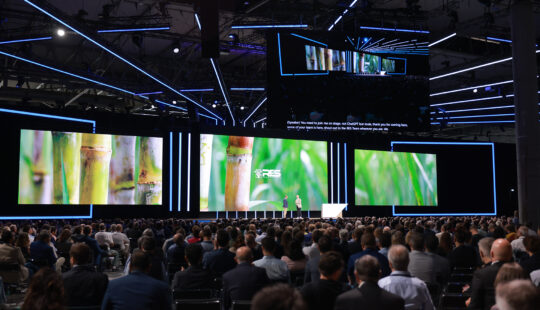While the world is in the grips of a pandemic, CEOs are devoting a new level of attention to a topic that is viewed by many as a more existential challenge than the coronavirus and has been neglected much too long: climate change.
COVID-19 has exposed the world’s vulnerability, but it also provides a shining example of how quickly countries can mobilize forces when faced with a global threat.
A triumvirate of forces — ecological, economic and societal — are currently encouraging leaders across many industries to take action to make their businesses more sustainable. Many leaders see a green recovery as an opportunity to forge a better world by reducing dependency on fossil fuels and stemming global warming. The World Economic Forum has even called on business leaders to “press the reset button on capitalism.”
Managing the “Green Line”
The shift toward sustainable business practices is being driven by governments, consumers, investors, and even employees. While most companies monitor and measure the CO2 emissions of their production sites, customers are increasingly demanding visibility into the full carbon footprint of the individual products they purchase. Discerning consumers are inclined to choose companies that deliver transparency while shunning those they view as indifferent to the environment.
In the future, national and international regulations may even require such environmental impact information be provided on product labels.
Company leaders will therefore need to do much more than just manage their top and bottom lines to keep investors happy; they are increasingly being held accountable for the way they are managing their “green line” to reduce the carbon footprint across their business.
Introducing SAP Product Carbon Footprint Analytics
This week, SAP announced the first solution in its Climate 21 program to support enterprises trying to make their operations better prepared for the emerging business reality where sustainability is a strategic and economic imperative.
Delivering product-specific carbon footprints in industries such as consumer products, chemicals, and oil and gas can be very complex, involving analysis of multiple production sites and production steps. But no other enterprise software company is prepared to help enterprises tackle the challenge like SAP.
“Climate 21 is the embodiment of the intelligent enterprise because it spans the end-to-end business processes across both companies and industries,” Thomas Saueressig, member of the Executive Board of SAP SE for SAP Product Engineering, said as he addressed participants at SAPPHIRE NOW.
For nearly 50 years, companies of all sizes and from all industries have trusted SAP to help them manage their enterprise resources to drive revenue, reduce cost, optimize asset utilization, streamline supply chains, and improve customer service. Much of the base data needed to determine carbon footprints is already in SAP systems, such as bill of materials, energy usage, procurement data and master data. SAP is also used to managing the complexity that such projects demand.
“It is in our DNA to build software that helps companies measure, account, and take the right action in dynamic and heterogeneous regulatory environments,” Saueressig wrote.
But SAP solutions for carbon accounting are not an afterthought bolted onto existing software applications; they are integral to the company’s digital core. Accounting for CO2 and other greenhouse gases is just an additional factor in an enterprise’s operations.
Carbon Emissions Accounted for Across the Entire Value Chain
SAP Product Carbon Footprint Analytics delivers carbon emission insights for a company’s products by plant, profit center, or cost center. Based on SAP S/4HANA, SAP Analytics Cloud and SAP Cloud Platform, the application delivers transparency on the carbon emissions of a product across the entire value chain, including production, raw materials, energy use, and transport. Producers can also integrate data from product databases and third-party solutions to analyze and understand the emissions breakdowns.
If a specific product is made in more than one location place, for example, comparisons can be made for each activity of the value chain to determine the amount of CO2 it takes to produce the product in each location. Transparency about the carbon footprint lays the foundation to minimize carbon emissions. Producers can use the data to run simulations to optimize the carbon footprint according to buyer requirements.
“Our goal is to create transparency about carbon emissions all the way through the value chain, across industries, geographies, products, and services,” said Toby Croucher, head of Solution Management for Climate 21 and Sustainability at SAP. “Creating transparency of the carbon footprint straight through to the consumer will help inform climate-responsible buying and consumption.”
Transparency about the product carbon footprint for any good or service can also be passed down the value chain to consumers, enabling buying decisions to be based not only on quality or cost. For example, a consumer shopping for a bicycle would be able to view the carbon footprint of the rims from Belgium, the titanium frame from Taiwan, the hub gears from the U.S., and tires from Germany, as well as the total carbon footprint of the bicycle delivered to the local bike store.
Co-Innovation Projects Lead the Way to Carbon Transparency and Climate Action
In addition to taking climate action in its own business operations, SAP is running numerous co-innovation projects with companies that are sustainability champions in their industries and understand the business value of taking the next step in managing their environmental impact.
Doehler is a global producer, marketer, and provider of technology-driven natural ingredients, ingredient systems, and integrated solutions for the food and beverage industry. Last month, it became the first company to go live with SAP Product Carbon Footprint Analytics.
Watch this space for more examples of companies that are acting today to responsibly manage their green line.



